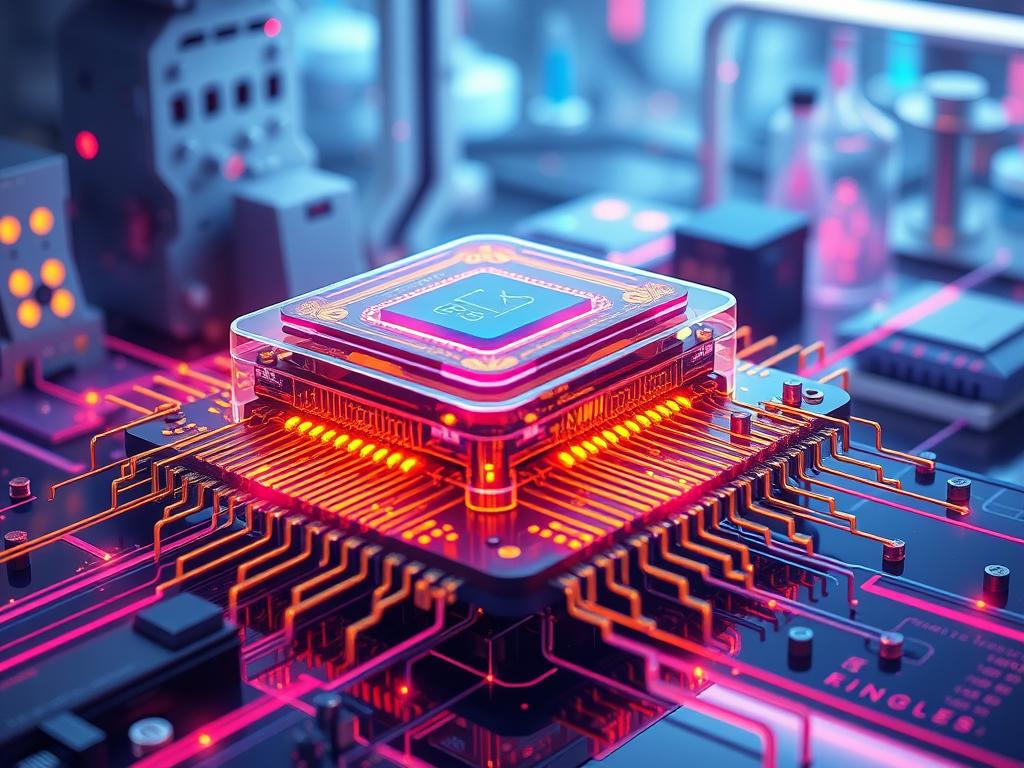The semiconductor industry is about to change dramatically. Junctionless transistors are emerging as traditional transistors reach their limits. These innovative devices could reshape ultra-scaled devices, offering simpler design and better performance.
Junctionless transistors mark a significant shift in semiconductor technology. They eliminate complex doping profiles, overcoming scaling limitations of conventional transistors. This approach could unlock a new generation of compact, energy-efficient electronic devices.
Let’s explore junctionless transistors’ unique operating principles and design considerations. We’ll also examine their potential applications in various fields. These innovative devices are opening doors to new possibilities in semiconductor technology.
Operating Principles
Junctionless transistors simplify semiconductor technology with a unique structure. They operate on principles distinct from traditional transistors. These innovative components are changing the game in electronics.
Channel Physics
Junctionless transistors have a uniformly doped channel, eliminating complex junctions. This design allows for smoother current flow and reduces quantum effects. The threshold voltage depends on the gate and channel materials’ work function difference.
Doping Effects
Doping uniformity is key in junctionless transistors. The entire channel has heavy doping with a single impurity type. This creates a consistent electrical environment throughout the device.
Uniform doping reduces variability and improves reliability. This is especially important as transistors shrink to nanoscale sizes.
Electrostatic Control
Junctionless transistors have superior electrostatic control due to their unique structure. The gate wraps around the channel, providing excellent current flow modulation. This design maintains strong control even at extremely small dimensions.
It helps reduce short-channel effects that often plague conventional transistors. The result is better performance in smaller devices.
| Feature | Junctionless Transistor | Conventional Transistor |
|---|---|---|
| Doping Profile | Uniform | Variable |
| Junction Formation | Not required | Critical |
| Electrostatic Control | Enhanced | Standard |
Device Design
Junctionless transistors are a game-changer in semiconductor tech. They simplify fabrication and overcome scaling limits. Let’s dive into the key design aspects that make these transistors unique.
Architecture Options
Junctionless transistors come in various designs. Nanowire structures offer excellent electrostatic control. Planar designs are easier to mass-produce.
Fin-based architectures balance performance and manufacturing complexity. Each type has its own advantages.
Material Selection
Materials are crucial for junctionless transistor performance. Silicon is common due to its well-known properties and availability. However, researchers are exploring new options:
- Germanium: Offers higher carrier mobility
- III-V compounds: Provide superior electron transport
- 2D materials: Show promise for ultra-thin devices
Dimensional Scaling
Shrinking junctionless transistors brings both opportunities and challenges. Smaller devices can perform much better. But this also increases quantum effects, requiring careful design.

| Dimension | Impact on Performance | Design Considerations |
|---|---|---|
| Channel Length | Affects switching speed | Balance with short-channel effects |
| Channel Width | Influences current drive | Trade-off with electrostatic control |
| Gate Oxide Thickness | Determines gate control | Consider leakage and reliability |
Optimizing these design elements pushes semiconductor tech forward. Junctionless transistors offer a new path beyond traditional scaling limits.
Fabrication Process
Junctionless transistors represent a big leap in semiconductor tech. They use new methods for even doping and simpler production. Let’s look at the key steps in making these devices.
Doping Methods
These transistors need exact doping for even charge carrier spread. Ion implantation and in-situ doping during growth are common techniques. They aim for uniform doping across the channel, removing the need for complex junctions.
Channel Formation
The channel in these transistors forms in a unique way. The whole channel gets even doping, unlike traditional transistors. This makes fabrication easier and improves process control.
Engineers use advanced lithography to fine-tune channel size for best performance. This approach allows for precise adjustments to meet specific device needs.
Contact Integration
Adding contacts is vital for these transistors to work. Metal layers go right on the heavily doped semiconductor areas. This direct method simplifies the fabrication process, cutting down steps in traditional manufacturing.
This streamlined process offers many benefits. It cuts production costs, boosts yield, and allows for better scaling. As the industry pushes for smaller devices, these methods pave the way forward.
They enable the creation of ultra-small transistors with improved performance. This advancement supports the ongoing trend of device miniaturization in the semiconductor field.
Performance Analysis
Junctionless transistors offer unique performance characteristics. They address key challenges in modern semiconductor technology. These devices show promise for future applications.
ON/OFF Characteristics
Junctionless transistors have remarkable ON/OFF behavior. They show sharp transitions between states, controlled by gate voltage. This results in a well-defined threshold voltage, crucial for efficient switching.
The absence of junctions reduces leakage current in the OFF state. This enhances overall device performance and efficiency.

Power Consumption
Junctionless transistors can reduce power consumption. Their simple structure minimizes parasitic capacitances, leading to lower dynamic power usage. Static power improves due to decreased leakage current.
These factors boost energy efficiency in active and standby modes. This makes them ideal for low-power applications.
| Parameter | Junctionless Transistor | Traditional Transistor |
|---|---|---|
| Leakage Current | Low | Higher |
| Threshold Voltage Control | Precise | Variable |
| Power Consumption | Reduced | Standard |
Speed Metrics
Speed is crucial in transistor performance. Junctionless designs show promising results in this area. The lack of doping gradients reduces carrier scattering.
This potentially leads to higher carrier mobility. As a result, these devices offer faster switching speeds and better frequency response. This makes them suitable for high-speed applications.
Scaling Advantages
Junctionless transistors offer big scaling benefits for ultra-scaled devices. They push size limits, simplify manufacturing, and cut costs. These innovative components are changing the game in electronics.
Size Reduction
Junctionless transistors shine in making things smaller. Their unique structure allows for tinier devices without losing power. This breakthrough leads to more compact and mighty electronic systems.
Process Simplification
Making junctionless transistors takes fewer steps than regular ones. This cuts down on errors and speeds up production. The simpler approach boosts yield rates and shortens manufacturing time.
Cost Benefits
Junctionless transistors help save money. Their simpler manufacturing process lowers production costs. Plus, smaller devices mean more chips per wafer, further cutting expenses.
| Aspect | Traditional Transistors | Junctionless Transistors |
|---|---|---|
| Device Size | Larger | Smaller |
| Manufacturing Steps | More complex | Simplified |
| Production Costs | Higher | Lower |
| Scaling Potential | Limited | Higher |
Junctionless transistors are key to beating scaling limits in semiconductor tech. They offer impressive size reduction and cost savings. This makes them a top choice for future electronic devices.
Implementation Challenges
Junctionless transistors offer big gains in semiconductor tech. However, their implementation faces several obstacles. These issues need careful thought for successful integration into current manufacturing.
Process Control Complexities
Precise process control is key for junctionless transistors. Even doping across the channel is vital for performance. Makers must create new ways to keep doping levels steady during production.

Addressing Variability Issues
Variability management is a big hurdle in making junctionless transistors. Small changes in channel size or doping can cause inconsistent behavior. Engineers are looking into new methods to reduce these issues.
Optimizing Production Yield
Boosting yield optimization is crucial for junctionless transistors to be commercially viable. Makers must balance performance needs with production efficiency. This means improving fabrication and using strong quality control.
| Challenge | Impact | Mitigation Strategy |
|---|---|---|
| Process Control | Inconsistent doping profiles | Advanced ion implantation techniques |
| Variability Management | Performance fluctuations | Statistical process control |
| Yield Optimization | Increased production costs | In-line metrology and defect analysis |
Solving these issues needs teamwork between designers, engineers, and equipment makers. As the industry improves junctionless transistor tech, these hurdles should lessen. This will pave the way for wide use in future electronic devices.
Applications
Junctionless transistors are changing semiconductor technology. Their unique structure creates new possibilities in electronics. These innovative devices are making an impact across different sectors.
Logic Devices
Junctionless transistors offer big advantages in logic devices. Their simple structure makes complex circuit fabrication easier. This results in more efficient logic devices that use less power.
The outcome is faster processing speeds in smaller chip sizes. This advancement is crucial for modern computing needs.
Memory Integration
Junctionless transistor technology greatly improves memory integration. These transistors allow for denser memory arrays, increasing storage capacity. This progress is key for creating more compact and powerful devices.
Analog Circuits
Junctionless transistors excel in analog circuits. Their linear features make them perfect for signal processing. This leads to better performance in audio amplification and sensor interfaces.
| Application | Advantage | Impact |
|---|---|---|
| Logic Devices | Simpler fabrication | Higher processing speeds |
| Memory Integration | Denser arrays | Increased storage capacity |
| Analog Circuits | Linear characteristics | Better signal processing |
Junctionless transistors show versatility across many applications. They enhance logic devices and revolutionize memory integration. These transistors also improve analog circuits significantly.
As research progresses, we can expect more breakthroughs in semiconductors. The future holds exciting applications in the semiconductor industry.
Future Prospects
Junctionless transistors are a promising solution for smaller devices in the semiconductor industry. They offer potential breakthroughs in scaling limits, allowing for ultra-compact chips. Their unique structure simplifies fabrication, potentially cutting costs and production time.
Pushing Boundaries
Junctionless transistors show promise in overcoming sub-10nm node challenges. Their simple design could enable further miniaturization, extending Moore’s Law. This advancement might lead to more powerful and energy-efficient devices soon.
Material Innovation
New materials are key to improving junctionless transistor performance. Researchers are looking into germanium and III-V compounds as alternatives to silicon. These materials could boost electron mobility and improve device efficiency.
This innovation may open doors to faster and more capable electronic systems. The search for better materials continues to drive progress in this field.
Industry Shifts
Major chip makers are investing in junctionless transistor research and development. They aim to integrate this technology into their product lines. We may see a gradual shift towards junctionless designs in various applications.
These applications could range from mobile devices to high-performance computing systems. The industry is adapting to this new technology’s potential benefits.


